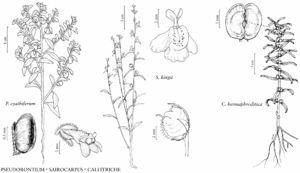Sairocarpus kingii
Revis. Antirrhineae, 470. 1988.
Common names: Least snapdragon
Selected by author to be illustratedEndemic
Basionym: Antirrhinum kingii S. Watson Botany (Fortieth Parallel), 215, plate 21, figs. 1–4. 1871
Revision as of 19:28, 24 September 2019 by FNA>Volume Importer
Annuals. Stems 3–45 cm, not self-supporting, glabrous; branches twining. Leaves opposite proximally, alternate distally; blade elliptic to linear, 5–35 × 1–7 mm, surfaces glabrous. Inflorescences axillary, flowers solitary. Pedicels 1–12 mm. Flowers chasmogamous and cleistogamous; calyx lobes unequal, glandular-hairy, adaxial lobe 4–5.5 × 1.5–2 mm; corolla white, purple-veined, 5.5–7 mm, base gibbous, mouth 3–3.5 mm diam., palate purple-veined, angular, 2.5–3 mm diam., minutely papillate. Capsules ovoid to globular, 3–4.5 mm, glandular-hairy, abaxial locule with 1 pore. Seeds black, 1 mm, reticulate, ridged, or tuberculate. 2n = 30.
Phenology: Flowering Apr–Jul.
Habitat: Washes, scree, rocky slopes.
Elevation: 500–2300 m.
Distribution
Ariz., Calif., Idaho, Nev., Oreg., Utah.
Discussion
Selected References
None.
Lower Taxa
None.
